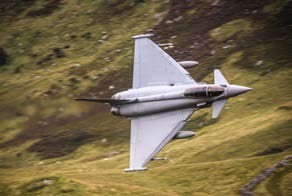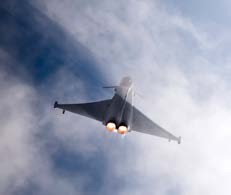
How did you get into aviation photography?
When I was a kid, I lived in a little village in Lincolnshire that was under the flight path for RAF Waddington. We used to see Vulcans and lots of other Cold War jets overhead. That sparked an interest. We also went to a lot of air shows at the base.
In the mid-90s, I studied art and design, which took me down the photography route. But then I started full-time work and, for a time, forgot about aircraft. Then, around 2012, I was on the way back from the coast and drove past RAF Coningsby. On the spur of the moment, I decided to stop and take some pictures. From that day, I got the bug again.
Over the next couple of years, I went from iPhone photography to investing in more sophisticated DSLR equipment. Around the same time, Instagram became massive. By then, I’d started working nights, which gave me a lot of free time during the day, meaning I went to the base two or three times a week.
My relationship with the Typhoon Display Team started after I began posting images on social media. From there, things grew into a good working relationship.
Is there a particular style that you think sums up your work?
My style is focused on the way the light touches a subject — be it a person, building, or aircraft. Once upon a time, a lot of my black-and-white photography was dubbed “aviation art noir.” I simply say I like my photography to come packed with emotion. I want the viewer to feel what I'm trying to convey, whether it be in the edit or the original photography.
I think having been to art school helps. But it also helps to have an understanding of the laws of physics, dynamics, and nature as well.
You can be skilled in terms of using a piece of equipment like a camera, but sometimes it’s understanding the laws of nature that helps you get those really good shots. Or to put it across in a way like an artist such as Turner would have done.

Why do you think the Typhoon is such a good subject?
It's a unique subject — with incredible power and speed. The delta wing is probably the key element; you see the sun reflecting off its surfaces. This means you can get brilliant, dynamic images. I grew up in the Cold War era amid a lot of rugged-looking machines. So when Typhoon came along, it was a very sleek design.
When did you then start getting commissions?
I was selling imagery, and then the commissions for work started. It was a small natural progression, which eventually led to working with Wings magazine. I got the front cover for that in the second edition of the magazine. Since then, I have been lucky enough to have also had images used on the Eurofighter calendar. I also produced the images used on the front cover of Mike Sutton's book, Typhoon.
Do you have a particular favourite shot of your own?
There are one or two that are special to me. The first is of a 3(F) Squadron Typhoon as it is taxiing directly towards me. I kept it black and white but left the hood in its natural colour to stand out. I used my dad's Fuji camera because I didn't have one then. After I posted that, the pilot got in touch. It meant a lot that the person in the photograph enjoyed it so much that they wanted it. I've got one on my front room wall, which I took back in 2014.
Another favourite is the image selected for the front cover of Wings and Mike Sutton’s book. It’s the same image. That particular image helped make my name as a photographer.
Finally, I’d go for another 2014 image. I had stopped off at RAF Coningsby, and I was taking some shots on my iPhone. The sky was like marble. In the edit, I took the light levels down, and it gave some fantastic silhouette shots. I’d select one of those too. I think it’s because at that period, the reaction to my work was positive, and it was a real catalyst for me.

